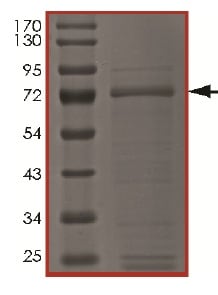Recombinant human c-Kit (mutated D820E) protein (ab184893)
Key features and details
- Expression system: Baculovirus infected Sf9 cells
- Purity: > 85% Densitometry
- Active: Yes
- Tags: proprietary tag N-Terminus
- Suitable for: SDS-PAGE, Functional Studies
-
Product name
Recombinant human c-Kit (mutated D820E) protein
See all c-Kit proteins and peptides -
Biological activity
The specific activity of ab184893 was determined to be 16 nmol/min/mg.
-
Purity
> 85 % Densitometry. -
Expression system
Baculovirus infected Sf9 cells -
Accession
-
Protein length
Protein fragment -
Animal free
No -
Nature
Recombinant -
-
Species
Human -
Sequence
TYKYLQKPMYEVQWKVVEEINGNNYVYIDPTQLPYDHKWEFPRNRLSFGK TLGAGAFGKVVEATAYGLIKSDAAMTVAVKMLKPSAHLTEREALMSELKV LSYLGNHMNIVNLLGACTIGGPTLVITEYCCYGDLLNFLRRKRDSFICSK QEDHAEAALYKNLLHSKESSCSDSTNEYMDMKPGVSYVVPTKADKRRSVR IGSYIERDVTPAIMEDDELALDLEDLLSFSYQVAKGMAFLASKNCIHRDL AARNILLTHGRITKICDFGLARDIKNESNYVVKGNARLPVKWMAPESIFN CVYTFESDVWSYGIFLWELFSLGSSPYPGMPVDSKFYKMIKEGFRMLSPE HAPAEMYDIMKTCWDADPLKRPTFKQIVQLIEKQISESTNHIYSNLANCS PNRQKPVVDHSVRINSVGSTASSSQPLLVHDDV -
Predicted molecular weight
73 kDa -
Amino acids
544 to 976 -
Modifications
mutated D820E -
Tags
proprietary tag N-Terminus
-
Preparation and Storage
-
Alternative names
- C Kit
- c-Kit
- c-Kit Ligand
see all -
Function
Tyrosine-protein kinase that acts as cell-surface receptor for the cytokine KITLG/SCF and plays an essential role in the regulation of cell survival and proliferation, hematopoiesis, stem cell maintenance, gametogenesis, mast cell development, migration and function, and in melanogenesis. In response to KITLG/SCF binding, KIT can activate several signaling pathways. Phosphorylates PIK3R1, PLCG1, SH2B2/APS and CBL. Activates the AKT1 signaling pathway by phosphorylation of PIK3R1, the regulatory subunit of phosphatidylinositol 3-kinase. Activated KIT also transmits signals via GRB2 and activation of RAS, RAF1 and the MAP kinases MAPK1/ERK2 and/or MAPK3/ERK1. Promotes activation of STAT family members STAT1, STAT3, STAT5A and STAT5B. Activation of PLCG1 leads to the production of the cellular signaling molecules diacylglycerol and inositol 1,4,5-trisphosphate. KIT signaling is modulated by protein phosphatases, and by rapid internalization and degradation of the receptor. Activated KIT promotes phosphorylation of the protein phosphatases PTPN6/SHP-1 and PTPRU, and of the transcription factors STAT1, STAT3, STAT5A and STAT5B. Promotes phosphorylation of PIK3R1, CBL, CRK (isoform Crk-II), LYN, MAPK1/ERK2 and/or MAPK3/ERK1, PLCG1, SRC and SHC1. -
Tissue specificity
Isoform 1 and isoform 2 are detected in spermatogonia and Leydig cells. Isoform 3 is detected in round spermatids, elongating spermatids and spermatozoa (at protein level). Widely expressed. Detected in the hematopoietic system, the gastrointestinal system, in melanocytes and in germ cells. -
Involvement in disease
Piebald trait
Gastrointestinal stromal tumor
Testicular germ cell tumor
Leukemia, acute myelogenous -
Sequence similarities
Belongs to the protein kinase superfamily. Tyr protein kinase family. CSF-1/PDGF receptor subfamily.
Contains 5 Ig-like C2-type (immunoglobulin-like) domains.
Contains 1 protein kinase domain. -
Post-translational
modificationsUbiquitinated by SOCS6. KIT is rapidly ubiquitinated after autophosphorylation induced by KITLG/SCF binding, leading to internalization and degradation.
Autophosphorylated on tyrosine residues. KITLG/SCF binding enhances autophosphorylation. Isoform 1 shows low levels of tyrosine phosphorylation in the absence of added KITLG/SCF (in vitro). Kinase activity is down-regulated by phosphorylation on serine residues by protein kinase C family members. Phosphorylation at Tyr-568 is required for interaction with PTPN11/SHP-2, CRK (isoform Crk-II) and members of the SRC tyrosine-protein kinase family. Phosphorylation at Tyr-570 is required for interaction with PTPN6/SHP-1. Phosphorylation at Tyr-703, Tyr-823 and Tyr-936 is important for interaction with GRB2. Phosphorylation at Tyr-721 is important for interaction with PIK3R1. Phosphorylation at Tyr-823 and Tyr-936 is important for interaction with GRB7. -
Cellular localization
Cell membrane and Cytoplasm. Detected in the cytoplasm of spermatozoa, especially in the equatorial and subacrosomal region of the sperm head. - Information by UniProt
Images
-
The specific activity of c-Kit (ab184893) was determined to be 9 nmol/min/mg as per activity assay protocol and was equivalent to 16 nmol/min/mg as per radiometric assay
-
SDS PAGE analysis of ab184893
-
SDS PAGE analysis of ab184893
-
SDS-PAGE analysis of ab184893.
-
Kinase Assay determining the specific activity of ab184893 to be 16 nmol/min/mg.


















